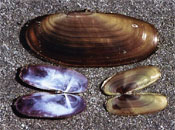Razor Clam

Photo: Razor shells. Photo Rick Harbo.
Latin Name
Siliqua patula
Group Name
Molluscs
Species Biology
Razor clams (Siliqua patula) are found on surfswept sandy beaches from Pismo Beach, California to the Aleutian Islands in Alaska. There are two major stocks in British Columbia: the largest occurring at North Beach near Massett in Haida Gwaii and smaller populations at Long Beach and other west coast of Vancouver Island beaches. Razor clams are found from the mid-intertidal beach region to subtidal depths of 20 m.
Razor clams are molluscs, having a long siphon, a prominent muscular foot and brittle elongated valves. They can use their foot to burrow at rates exceeding 20 cm per minute and are found up to 25 cm in the sand. Adults left on the surface of the beach will quickly re-burrow. Adult razor clams reach shell lengths up to 160 mm and ages of 18 years. Time of spawning varies with location, but generally occurs from April to September, occurring later at northern latitudes. Age and size of sexual maturity varies with latitude, but most clams are sexually mature at 2 to 4 years of age and 100 mm in length.
Fishery
The management plan for razor clams has been jointly developed by the Council of the Haida Nation (CHN) and Fisheries and Oceans Canada. This managment plan applies to the commercial, recreational and Haida non-commercial fisheries. In 2004, the CHN will continue to designate Haida Participants in the commercial fishery who will commercially fish razor clams under a Communal Licence issued to the CHN under the Razor Clam Sub-agreement. Fisheries and Oceans Canada will continue to license individual commercial fishers (Licensees). Entry into this fishery was limited in 1995.
Historically most commercially harvested razor clams were used as bait in the crab fishery. In recent years, however, there has been a growing demand for razor clams as a food product. This demand along with recent clam abundances resulted in historic high landings. The fishery experienced a record catch in 2000 (since 1941) and then three years of above average catches. Recent recruitment has been at a more normal level and catch ceilings have been adjusted to reflect the available stock.
When harvesting razor clams (Siliqua patula) for sale, each participant must be in possession of a non-transferable designation card from the CHN and each Licensee must be in possession of a current year Area A clam "Z-2" licence from Fisheries and Oceans Canada. Identification and designation cards or licences must be carried at all times when harvesting clams and must be produced upon request of a CHN Fisheries Guardian, Fisheries and Oceans Canada Fishery Officer, or Fisheries and Oceans Canada Fishery Guardian.
Recreational harvesters are required to hold a valid British Columbia Tidal Waters Sport Fishing Licence to harvest razor clams.
- Date modified: